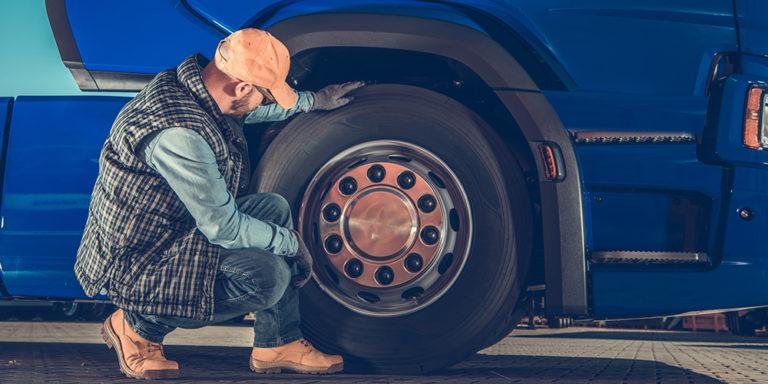How Truckers can Stay Safe on the Road in Extreme Weather
February 21st, 2022
By Arrow Truck Marketing
As an owner/operator or a leased-on driver, you know you need to work hard to protect yourself and your trucks while driving and keep other drivers on the road safe. All D.O.T certified drivers have passed safety training courses to obtain their CDL licenses, and you have complete faith in your fellow drivers to drive safely.
However, you also know that unexpected poor weather can test even the best drivers. For instance, in April 2015, sudden high winds in Utah and Nevada stopped freeway traffic for hours after toppling three semi-trucks and causing a 17-car pileup. In Wyoming, the same high winds brought a severe snowstorm that closed the freeway for 20 hours after 50 cars and dozens of semi-trucks crashed.
Since extreme weather can happen anytime and anywhere, drivers need to be prepared to navigate the worst weather. Read below for basic safety tips on how to drive in wind, rain, and snow and pass these tips along to other truck drivers.
General Safety Tips
Some safety tips apply to all weather conditions, any time of the year. Ensure that that you follow these basic precautions no matter the season.
Check the Weather Well in Advance
While the weather often changes with little warning, groups like the National Weather Service do their best to stay on top of weather changes and issue severe weather alerts. Download the NWS app (http://mobile.weather.gov/#typeLocation) or any of a number of weather apps to get real-time weather updates in any area.
Obey the Law
It might be tempting to break the speed limit, drive in the left lanes, or drive after only a few hours of sleep, but you should avoid these behaviors at all costs. Drivers should always wear a seatbelt and keep both hands on the wheel. Following the law will keep you and others safe in both typical and extreme weather conditions.
Maintain Trucks
When you purchase a high-quality used vehicle and take good care of it, it will take care of you as well. Paying a little extra to get good vehicles in good condition will return safety dividends in the long run. Practice preventative maintenance and keep your truck in good shape.
Increase Follow Distance and Decrease Speed
High winds, rain, and snow all decrease driver visibility, which makes staying further behind cars more important than ever. Rain and snow also increase the amount of time trucks need to stop. As soon as the weather worsens, slow down and follow further behind.
Prepare an Emergency Kit
Drivers should keep emergency kits with food, water, extra fuel, a cell phone and charger, first aid kit, and a warm blanket in the cab.
Wind Safety
Because of their height, semi-trucks have a much harder time staying upright in strong winds than cars or pickups. Remember this key safety tips to avoid a fall in high winds.
Know How Much Weight Is in the Trailer
Drivers already know to pay attention to their trailer’s load. However, in high winds, the trailer’s load and weight become even more crucial to the truck’s stability. You should never attempt to take light or empty trailers through windy conditions.
Balance the Load
Even if the truck has a full trailer, the wind can still push it around if the truck has a high center of gravity or the load becomes unbalanced. The driver should be aware of how likely the trailer’s contents are to shift and how high the truck’s center of gravity is. If the truck is too high to endure strong winds, stay off the road.
Keep Both Hands on the Wheel
Wind can jerk the truck’s control out of your driver’s hands. In high wind, both hands need to stay on the wheel at all times for maximum control.
Snow Safety
Add Chains
If the weather becomes too snowy or icy, the truck will likely need chains. You should have the right size and amount of chains on hand. Make sure to keep a flashlight, kneeling pad, waterproof gloves, and a reflective vest in the cab to make the chaining process as easy and safe as possible.
Add Anti-Gel
At low temperatures, diesel fuel gets slushy. Add anti-gel to the tank before you fuel up. The nearest auto shop might not have any in stock, especially if the below-freezing temperatures are unseasonable, so make sure you purchase some and keep it on-hand for sudden cold spells.
Rain Safety
Beware of Hydroplaning
Hydroplaning occurs when a truck hits a slick patch of rain at high speeds. To minimize hydroplaning effects, drivers should slow down, turn on the headlights to increase visibility, and create a large space between their truck and other cars.
Be Aware in Fog
Fog occasionally accompanies rain. To drive safely in fog, stay alert and engage the fog lights and low-beam headlights. Never use high-beam headlights in fog. Defrost the windshields, follow the taillights of the car just ahead, and clean the lights before getting on a foggy road.
With these safety tips in mind, you are sure to have long, happy and safe travels. Visit your truck dealership to find a used truck that keeps your driver safe in any weather!

